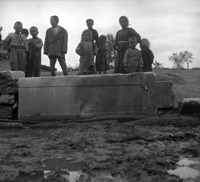 MAMA XI 99 (Akmoneia)
MAMA XI 99 (Akmoneia) 
Honorific stele for Tatia, daughter of Menokritos
- Type of monument:
- Honorific stele.
- Location:
- İslâmköy (Akmoneia): in a fountain.
- Description:
- White Dokimeian marble stele with pilasters at sides and tenon below. Broken above and at sides of base.
- Dimensions:
- Ht. 2.12+ (including base and tenon); width 0.66 (pilasters 0.14; tenon 0.35); thickness 0.19-0.21 (base and tenon 0.28); letters 0.018-0.025.
- Record:
- Squeeze; line drawing; MB notebook copy; photograph (1955/109).
- Publication:
- Thonemann 2010.
- Date:
- AD 6/7 (Year 91 of Sullan era)
[- - - - - - - - - γυ]-
ναῖκες Ἑλληνί-
δες τε καὶ Ῥωμαῖ-
αι ἐτείμησαν Τα-
τίαν Μηνοκρίτου
5 τὴν καὶ Τρυφῶσαν
γυναῖκα δὲ Μηνο-
δότου Μενελάου
τοῦ καὶ Σίλλωνος
τὴν ἀρχιιέρηαν εὐ-
10v. εργέτιν ἐμ παν-
τὶ καιρῷ γενηθεῖ-
σαν αὐτῶν πάσ-
ης ἀρετῆς ἕνε-
κεν. vac.
15τὴν ἐπιμέληαν
ποιησαμένου Κρά-
τητος Μηνοκρίτου
τοῦ καὶ Μενελάου καὶ
Ποπλίου Πετρω-
20νίου Ἐπιγένους
καὶ Μηνοκρίτου
Ἀγαθοκλέως.
ἔτους v. α v. ϙ´
... the women, both Greek and Roman, honoured Tatia, also called Tryphosa, daughter of Menokritos, wife of Menodotos, also called Sillon, son of Menelaos, the high-priestess, having acted as their benefactor in all circumstances, for the sake of all her virtue. Krates, also known as Menelaos, son of Menokritos, Publius Petronius Epigenes, and Menokritos son of Agathokles were responsible (for setting up the stele). Year 91.






This monument is an honorific stele, voted by ‘the Greek and Roman women’ for a certain Tatia, daughter of Menokritos, who has acted as high-priestess of a civic cult or group of cults, possibly, but not necessarily, the civic imperial cult. One of the three men responsible for the erection of the monument is named Menokritos (line 21), and another is a ‘son of Menokritos’ (line 17); it seems likely that at least one of these two men is a close relative of the honorand (father or brother?). The inscription is dated ‘Year 91’ (line 23). Since the Sullan era (from autumn 85 BC) was in use at Akmoneia (Leschhorn 1993: 263-5), our text can be firmly dated to the year AD 6/7.
Two of the individuals mentioned in this inscription also appear on the coinage of Akmoneia. Krates son of Menokritos (lines 16-17) is attested as a mint-magistrate at Akmoneia in the latter years of the reign of Augustus (RPC I 3168), and Menodotos Sillon (lines 6-8) is known from the autonomous bronze coinage of Akmoneia (BMC Phrygia 6, nos. 15-16; SNG Von Aulock 3366; GM Winterthur 4011; Triton V 500). The precise dating of this autonomous bronze coinage has hitherto been uncertain (late second/first century BC); we can now say with some confidence that it immediately precedes, or even overlaps with, the earliest Roman provincial coinage of Akmoneia, around the turn of the era.
Publius Petronius Epigenes (lines 19-20) has evidently gained the Roman citizenship through a member of the gens Petronia, no doubt through manumission. P. Petronius (PIR2 P 269), proconsul of Asia AD 29-35, is too late, and neither P. Petronius (PIR2 P 270), prefect of Egypt 25-22 BC, nor his son P. Petronius Turpilianus, triumvir monetalis c. 19 BC (PIR2 P 314), are known to have had any connection with the province of Asia. The most likely candidate is perhaps P. Petronius, an Italian negotiator on Delos in the early first century BC (I.Delos 2612, II 9). For other Petronii in the region of Akmoneia, see the commentary to MAMA XI 66 (1956/34: Sebaste).
The main point of interest in this text is the honouring body (lines 1-2): [γυ]ναῖκες Ἑλληνίδες τε καὶ Ῥωμαῖαι, ‘the women/wives, both Greek and Roman’. For a full discussion of this phrase, and its significance, see Thonemann 2010.